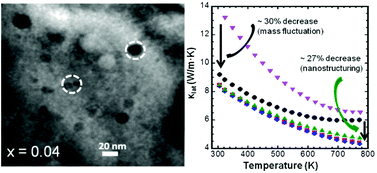Electronic and phonon transport in Sb-doped Ti0.1Zr0.9Ni1+xSn0.975Sb0.025 nanocomposites
Abstract
The thermoelectric behavior of n-type Sb-doped half-Heusler (HH)–full-Heusler (FH) nanocomposites with general composition Ti0.1Zr0.9Ni1+xSn0.975Sb0.025 (x = 0, 0.02, 0.04, 0.1) was investigated in the temperature range from 300 to 775 K. Samples used for structural characterization and transport measurements were obtained through the solid-state reaction of high purity elements at 950 °C and densification of the resulting polycrystalline powders using a uniaxial hot press. X-ray diffraction study of the powder samples suggested the formation of single-phase HH alloys regardless of the Ni concentration (x value). However, high resolution transmission electron microscopy investigation revealed the presence of spherical nanoprecipitates with a broad size distribution coherently embedded in the HH matrix. The size range and dispersion of the precipitates depend on the concentration of Ni in the starting mixture. Well dispersed nanoprecipitates with size ranging from 5 nm to 50 nm are observed in the nanocomposite with x = 0.04, while severe agglomeration of large precipitates (>50 nm) is observed in samples with x = 0.1. Hall effect measurements of various samples indicate that the carrier concentration within the Sb-doped HH matrix remains nearly constant (∼7 × 1020 cm−3) for samples with x = 0.02 and x = 0.04, whereas a significant increase of the carrier concentration to ∼9 × 1020 cm−3 is observed for the sample with x = 0.1. Interestingly, only a marginal change in thermopower value is observed for various samples despite the large difference in the carrier density. In addition, the carrier mobility remains constant up to x = 0.04 suggesting that the small nanoprecipitates in these samples do not disrupt electronic transport within the matrix. Remarkably, a large reduction in the total thermal conductivity is observed for all nanocomposites, indicating the effectiveness of the embedded nanoprecipitates in scattering phonons while enabling efficient electron transfer across the matrix/inclusion interfaces.


 Please wait while we load your content...
Please wait while we load your content...